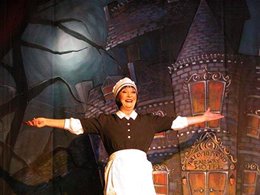In the programme notes to the original production of Hugh Leonard’s The Lily Lally Show at the Abbey Theatre in 1994, the author proposed that there had only ever been one great comedienne in Irish entertainment. Typically, Leonard didn’t name her but it was understood that he was talking about the late, great Maureen Potter. Leonard went on to stress that Mary Moone was his attempt to create the second great Irish comedienne. Thus, with obvious and deliberate, even comical, disingenuousness, Leonard’s statements were, like many of those uttered by the stars of that popular vaudeville and comic era, designed to deflect from the true state of affairs.
In Bewley’s Cafe Theatre’s revival of their own production of the play from 2003, Barbara Brennan again plays the inimitable Mary Moone. Throughout, Mary jumps from her public persona which is all bluster and thunder and full of gruff resilience to a more tender, private self which the public never got to see until now. In a nutshell, this is the tears of a clown scenario. Mary herself remarks about a comedian who she worked with, that she’s never known any funny man who wasn’t completely miserable. She might well be talking about herself, too.
Both in tone and in theme, The Lily Lally Show perfectly encapsulates a type of Dublin character who is no longer with us. Through the single and singular personality of Mary Moone – who changes to her stage name from Mooney, something of a joke on the usual transformations from normal to stage name – The Lily Lally Show conjures up a bygone era, probably that of the 1950s in Dublin when the great stars of the popular stage packed them in, in venues like the Queens and the Theatre Royal in Dublin.
 The ostensible tale is that the once great Mary Moone, who never did auditions, finally has to do one now, out of desperation and straitened times, for a children’s radio/television show. Brennan addresses both us the audience and her anonymous and invisible judge in the audition that she continually threatens to leave. The splash of naive art as a mis-en-scene behind her reminds us that Mary’s audition is for a children’s show.
The ostensible tale is that the once great Mary Moone, who never did auditions, finally has to do one now, out of desperation and straitened times, for a children’s radio/television show. Brennan addresses both us the audience and her anonymous and invisible judge in the audition that she continually threatens to leave. The splash of naive art as a mis-en-scene behind her reminds us that Mary’s audition is for a children’s show.
Another layer is added to the resonance of the production by dressing Brennan in one of the old French maid outfits that used to be worn by workers in Bewley’s Cafe, the venue for this production. Mary Moone is from the Dublin working classes. Everything about her, from her wit to her language and her expressive toughness of spirit bespeaks her class. As Mary rollercoasts through her career in bravura fashion we are also treated to moments of intimate heart-break.
Brennan excellently captures the mixture of pride and heartache that pervades Mary’s bones under the realisation that her era is passing. Mark O’ Halloran’s direction allows the great language of the play to shine through and he gives full reign to Brennan to explore the more universal themes of The Lily Lally Show: the addiction of performance, personal tragedy and the passing of time.
There’s warmth and empathy in the 2010 production of The Lily Lally Show, all of which allows the humanity and dignity of Leonard’s writing to share centre-stage with Barbara Brennan and her wonderful performance, the era and its characters becoming ever more a museum piece, as Mary Moone’s language and how she expresses herself are virtually extinct nowadays.
Patrick Brennan was chief theatre critic and arts writer with the Irish Examiner from 1990-2004. He is currently writing a book on the theatre of Tom Murphy.